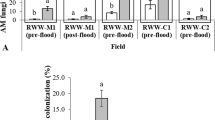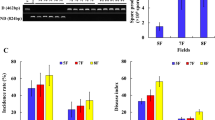Abstract
The symptoms of a growth disorder of cotton and associated properties of the soil were quantified. Data were collected from 35 sites across two irrigated fields that showed gradients in the severity of early season stunting of cotton. Ordination analysis of soil characteristics distinguished three groups of sites (A, B, and C) which corresponded to patterns of yield and early season growth. Group A and B soils had lower pH, finer texture and higher P, Zn, Mn and exchangeable Mg, K and Na than group C soils. Early season growth and arbuscular mycorrhizal colonisation of cotton at group A and B sites was much slower than at group C sites. Group B sites showed a recovery of yield later in the season while group A sites did not. Nutrient deficiencies, waterlogging, soil compaction, soil sodicity and Mn toxicity were unlikely causes of early season stunting, although soil Mn was a good predictor for the disorder. Thielaviopsis basicola, Verticillium dahliae and unidentified Chytridiomycetes were not associated with stunting and reduced yield, although other fungal pathogens may have been present. Root browning was a symptom of the disorder and suggests that pathogens, perhaps bacteria, play a causal role. This study showed that the growth disorder involved an interaction between cotton and the soil flora which was associated with heavy soil texture.
Similar content being viewed by others
References
Allen M F, Allen E B and Friese C F 1989 Responses of the non-mycotrophic plant Salsola kali to invasion by vesicular-arbuscular mycorrhizal fungi. New Phytol. 111, 45–49.
Allen S J 1990 Thielaviopsis basicola, a new record on cotton in Australia. Australas. Plant Pathol. 19, 24–25.
Alström S 1987 Factors associated with detrimental effects of rhizobacteria on plant growth. Plant and Soil 102, 3–9.
Anderson D L and Henderson L J 1986 Sealed chamber digestion for plant nutrient analysis. Agron. J. 78, 937–938.
Alström B and Gerhardson B 1989 Wheat cultivar reactions to deleterious rhizosphere bacteria under gnotobiotic conditions. Plant and Soil 117, 157–165.
Bell A A 1992 Verticillium wilt. In Cotton Diseases. Ed. R J Hillocks. pp 87–126. CAB International, Wallingford, UK.
Bridge J 1992 Nematodes. In Cotton Diseases. Ed. R J Hillocks. pp 331–353. CAB International, Wallingford, UK.
Brown J F, Allen S J and Constable G A 1990 Mycorrhizas and plant nutrition: long fallow disorder and cotton. In Proceedings of the 5th Australian Cotton Conference. pp 7–2. Australian Cotton Crowers' Research Association, Broadbeach, Australia.
Colwell J D 1965 An automatic procedure for the determination of phosphorus in sodium hydrogen carbonate extracts of soil. Chem. Indust. 84, 893–895.
Day P R 1965 Particle fractionation and particle-size analysis. In Agronomy, No. 9, Part 1. Methods of Soil Analysis. Ed. C A Black. pp 545–567. American Society of Agronomy, Madison, WI, USA.
Emerson W W 1983 Inter-particle bonding. In Soils: an Australian Viewpoint. pp 477–498. Division of Soils, CSIRO, Melbourne, Australia.
Evans G 1967 Verticillium wilt of cotton—the situation in the Namoi Valley. Agric. Gaz. NSW 78, 580–584.
Foy C D 1984 Physiological effects of hydrogen, aluminum, and manganese toxicities in acid soil. In Soil Acidity and Liming. Agronomy Monograph 12 (2nd ed.). Ed. F Adams. pp 57–97. American Society of Agronomy Inc., Madison, USA.
Foy C D, Fleming A L and Armiger W H 1969 Differential tolerance of cotton varieties to excess manganese. Agron. J. 61, 690–693.
Giovannetti M and Mosse B 1980 An evaluation of techniques for measuring vesicular arbuscular mycorrhizal infection in roots. New Phytol. 84, 489–500.
Hillocks R J 1992 Seedling diseases. In Cotton Diseases. Ed. R J Hillocks. pp 1–389. CAB International, Wallingford, UK.
Hodges S C 1992 Nutrient deficiency disorders. In Cotton Diseases. Ed. R J Hillocks. pp 355–403. CAB International, Wallingford, Oxon, UK.
Hodgson J M 1976 Soil Survey Field Handbook: Describing and Sampling Soil Profiles. Harpenden, Herts, UK. 99p.
Hodgson A S 1982 The effects of duration, timing and chemical amelioration of short-term waterlogging during furrow irrigation of cotton in a cracking grey clay. Aust. J. Agric. Res. 33, 1019–1028.
Irving G C J and McLaughlin M J 1990 A rapid and simple field test for phosphorus in Olsen and Bray No. 1 extracts of soil. Commun. Soil Sci. Plant Anal. 21, 2245–2255.
Isakiet T, Magarey R C and Croft B J 1992 Transmission of soilborne yield decline of sugarcane in northern Queensland, Australia. Phytopathology 82, 1089.
Johnson N C and Pfleger F L 1992 Vesicular-arbuscular mycorrhizae and cultural stresses. In Mycorrhizae in Sustainable Agriculture. Eds. G B Bethlenfalvay and R G Linderman. pp 1–27. American Society of Agronomy, Madison, WI, USA.
Koske R E and Gemma J N 1989 A modified procedure for staining roots to detect VA mycorrhizas. Mycol. Res. 92, 486–488.
Linderman R G 1992 Vesicular-arbuscular nnycorrhizae and soil microbial interactions. In Mycorrhizae in Sustainable Agriculture. Eds. G B Bethlenfalvay and R G Linderman. pp 45–70. American Society of Agronomy, Madison, WI, USA.
Lindsay W L and Norvell W A 1978 Development of a DTPA soil test for zinc, iron, manganese and copper. Soil Sci. Soc. Am. J. 42, 421–428.
Loveday J and Bridge B J 1983 Management of salt-affected soils. In Soils: an Australian Viewpoint. pp 843–855. Division of Soils, CSIRO, Melbourne, Australia.
Mahdi A A and Atabani I M A 1992 Response of Bradyrhizobium-inoculated soyabean and lablab bean to inoculation with vesicular-arbuscular mycorrhizae. Exp. Agric. 28, 399–407.
McGarry D and Chan K Y 1984 Preliminary investigation of clay soils' behaviour under furrow irrigated cotton. Aust. J. Agric. Res. 22, 99–108.
Ogle H J, Stirling A M and Dart P J 1993 Pathogenicity of fungi associated with seedling disease of cotton. Aust. J. Soil Res. 33, 923–929.
Olsson S and Gerhardson B 1992 Effects of long-term barley monoculture on plant-affecting soil microbiota. Plant and Soil 143, 99–108.
Parra-Garcia M D, Lo Guidice V and Ocampo J A 1992 Absence of VA colonisation in Oxalis pes-caprae inoculated with Glomus mosseae. Plant and Soil 145, 298–300.
Pearson J N, Smith S E and Smith F A 1991 Effect of photon irradiance on the development and activity of VA mycorrhizal infection in Allium porrum. Mycol. Res. 95, 741–746.
Price N S, Roncadori R W and Hussey R S 1989 Cotton root growth as influenced by phosphorus nutrition and vesicular-arbuscular mycorrhizas. New Phytol. 111, 61–66.
Rayment G E and Higginson F R 1992 Australian Laboratory Handbook of Soil and Water Chemical Methods. Inkata Press, Melbourne, Australia. 380 p.
Rich J R and Bird G W 1974 Association of early-season vesicular-arbuscular mycorrhizae with increased growth and development of cotton. Phytopathology 64, 1421–1425.
Smith G S and Roncadori R W 1986 Responses of three vesicular-arbuscular mycorrhizal fungi at four soil temperatures and their effects on cotton growth. New Phytol. 104, 89–95.
Smith R G, Hicks S K, Lloyd R W, Gannaway J R and Zak J 1989 VA mycorrhizal infection and its implication in the “fallow syndrome” associated with cotton grown in previously fallowed soils. In Proceedings of the Beltwide Cotton Production Research Conferences. Ed. J M Brown. p 375. National Cotton Council, Memphis, USA.
Suslow T V and Schroth M N 1982 Role of deleterious rhizobacteria as minor pathogens in reducing crop growth. Phytopathology 72, 111–115.
Thompson J P 1994 Inoculation with vesicular-arbuscular mycorrhizal fungi from cropped soil overcomes long-fallow disorder of linseed (Linum usitatissimum L.) by improving P and Zn uptake. Soil Biol. Biochem. 26, 1133–1143.
Till A R, McArthur G S and Rocks R L 1984 An automated procedure for the simultaneous determination of sulphur and phosphorus and of radioactivity in biological samples. In Proceedings of Sulphur 84. pp 649–660. Sulphur Development Institute Canada, Calgary, Canada.
Author information
Authors and Affiliations
Rights and permissions
About this article
Cite this article
Nehl, D.B., Allen, S.J. & Brown, J.F. Mycorrhizal colonisation, root browning and soil properties associated with a growth disorder of cotton in Australia. Plant Soil 179, 171–182 (1996). https://doi.org/10.1007/BF00009326
Received:
Accepted:
Issue Date:
DOI: https://doi.org/10.1007/BF00009326




